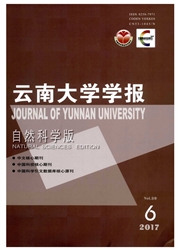

 中文摘要:
中文摘要:
为研究云南稻核心种质回交后代糙米总黄酮含量,本实验分别以143份云南籼稻核心种质与滇屯502,241份云南粳稻核心种质与合系35配制的杂种F6,BC2F4,BC3F3,BC4F2为材料,采用比色法对其糙米总黄酮含量进行测定分析.结果表明,籼稻后代黄酮含量高于粳稻后代;有色米高于无色米;不同世代的黄酮含量(mg/100g)情况籼稻后代是轮回亲本(236.26)〉BC2F4(224.69)〉BC4F2(222.36)〉BC3F3(210.19),但差异不显著;粳稻后代是BC4F2(244.42)〉BC2F4(239.58)〉轮回亲本(227.21)〉F6(220.03)〉BC3F3(190.91),其中BC3F3代极显著低于BC2F4,BC4F2代.筛选出的粳稻后代(白镰刀谷/合系353)是供试材料中含量最高的,达到1267.62±54.79mg/100g.
 英文摘要:
英文摘要:
The generations F6, BC2F4, BC3F3, BC4F2 were prepared through the hybridization between Diantun502 and 143 Indica rice core collections and between Hexi35 and 241 Japonica rice core collections in Yunnan to determine and analyze the flavonoid contents of the brown rice by spectrophotometry.The results showed that GABA contents were higher in Indica backcross generations than in Japonica ones,and were also higher in the colored rices than in the colorless;and for the different backcross generations, flavonoid contents were followed by the recurrent parents (236.26)〉 BC2F4 (224.69)〉 BC4F2 (222.36)〉 BC3F3 (210.19) in Indica without significant difference, but BC4F2 (244.42)〉 BC2F4 (239.58)〉 the recurrent parent(227.21) 〉F6 (220.03)〉 BC3F3 (190.91) in Japonica, in which flavonoid contents were most significantly lower in BC3F3 than in BC2F4 and BC4F2.Japonica descendants (Bailiandaogu / Hexi 353) had the highest flavonoid contents in the all tested materials with (1267.62 ± 54.79)mg/100g.
 同期刊论文项目
同期刊论文项目
 同项目期刊论文
同项目期刊论文
 期刊信息
期刊信息
